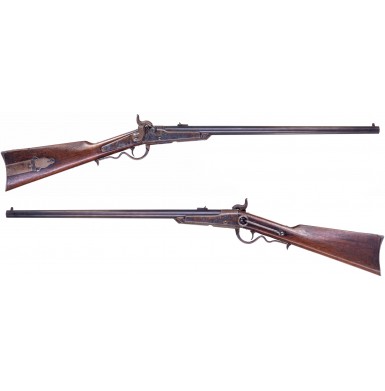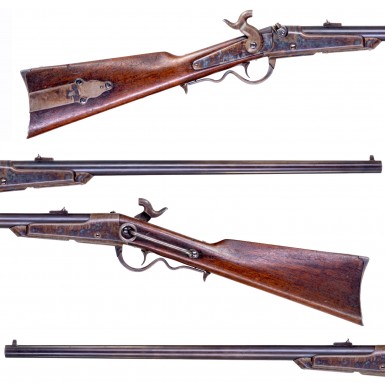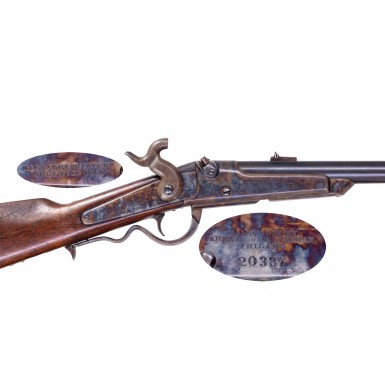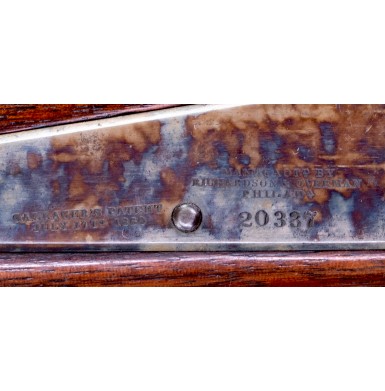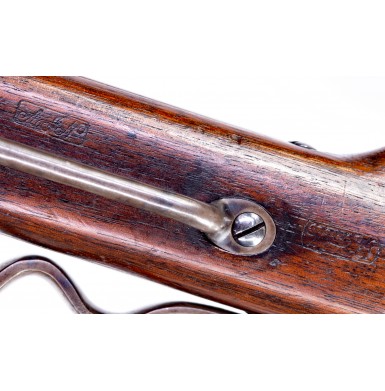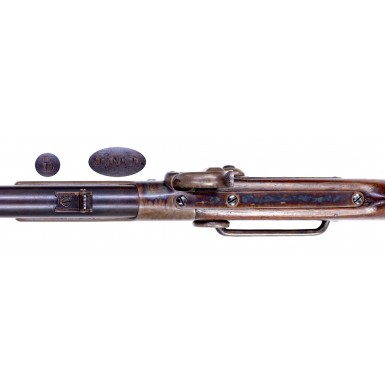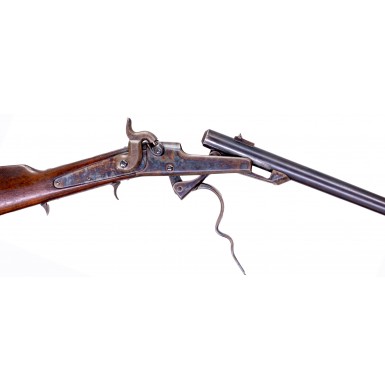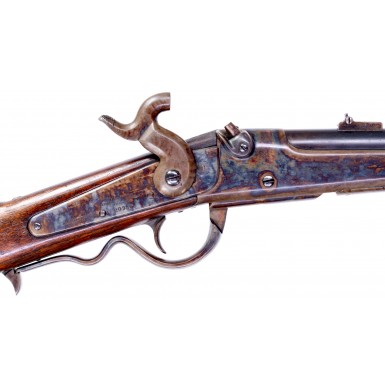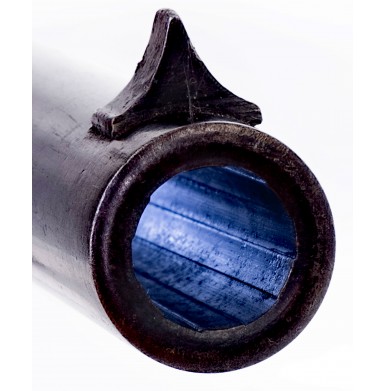Excellent New Model Gallager Rimfire Cartridge Cavalry Carbine
- Product Code: FLA-4033
- Availability: In Stock
-
$4,795.00
The design for what would become known to collectors as the Gallager Carbine was patented by Dr. Malhon J Gallager on July 17, 1860. Like a number of 19th Century American firearms inventors including Doctors Edward Maynard and Richard Gatling, Gallager was in the medical field. At the time he received his patent he was working as a dentist in Savannah, GA. He was also serving as the Medical Commissioner for the Heathcote Ward (3rd Ward) of Savannah. Gallager was what some would have referred to as a “Damn Yankee” in that he was born in Delaware in 1814, and later relocated to Savannah. Some references noted that he was a South Carolina native, but this is not borne out by the primary source historical evidence. Gallager married Anna Kunz in Philadelphia, PA on November 5, 1835, and their first of seven children, Ellen, was born on July 21, 1837, in West Chester, PA. Two more children followed rather quickly, Jacob Henry in June of 1840 and Lewis in 1842. In 1840 the family relocated to Philadelphia, PA and by 1849 they were living in Wilmington (New Castle County), DE with the addition to two more children, Anna in 1848 and Martha in 1849. The 1850 Census finds the Gallager family still in Wilmington, where Malhon was working as dentist and held real estate valued at $3,200. According to the website www.measuringworth.com, that would be equivalent to real estate worth $2.35 million dollars in today’s money. January 1851 brought daughter Martha Josephine to the family. On February 1, 1853, Thomas was born, but he barely survived a month, passing away on March 7. At that time the family was back in Philadelphia. Sometime between March of 1853 and 1859 the family relocated to Georgia, and apparently suffered some level of economic reversals, as Savannah court case indicates that Gallager was sued by a J.L. Jones for failure to pay a debt and was awarded $175 against the original debt of $87.50 on March 7, 1857. According to the 1860 Federal Census the family was living in Savannah’s District 3, Chatham County in dwelling #1564. Gallager had a personal estate valued at $1,000, which would be equivalent to a personal worth of $600,000 today, an improvement over the situation he found himself in only a couple of years earlier as a debtor with a judgement against him. According to the census the couple had five children living with them ranging in age from 9 to 21 years old, suggesting that Anna born in 1848 had passed away as well. Interestingly, despite being “northerners” the family would remain in Georgia through the Civil War and did not return to Delaware until 1865. Gallager continued to work as a dentist in the Wilmington area through at least 1885, when at the age of 70 he received a patronage position at the Philadelphia Mint through the efforts of both his congressman and a senator. A newspaper article noted that he was taking the newly vacated position of “Manager of the Open House”, which from the story appeared to be that of a glorified docent, explaining the mint operations and various types of coinage produced there to visitors. The article also noted that his dental business in Delaware was for sale to facilitate his relocation to Philadelphia. Gallager passed away in May of 1897 at the age of 83 and was buried in Bala Cynwyd on the outskirts of Philadelphia on May 20. No indication could be found that Gallager ever dabbled in firearms design beyond that of the gun that bears his name.
What motivated Gallager to dabble in the invention of a firearm is lost to history, but it is tempting to think that his financial issues of just a couple of years earlier may have motivated him to try to find a way to increase his income. It is also interesting to postulate why medical men like Gallager, Maynard and Gatling were motivated to design firearms. While Gatling clearly articulated his thought that the design was intended to make war so horrible as to end all future conflicts, it is more likely that the medical men of the era worked with interesting tools that might have been the seeds of inspiration for other designs. The gun that Gallager invented was an improvement in breechloading firearms design. The action was operated by an underlever that also formed the triggerguard, which pushed the barrel forward and tipped it down when the lever was lowered. The patent drawings and description do not show a lock or specify an ignition system, but rather concentrate on the operation of opening the action which Gallager specifically notes is designed to keep a fired cartridge casing from being lodged in the chamber. The Patent Application reads in part:
“A difficulty exists in breech-loading cartridge-guns in the sticking of the cartridge shell or case in the gun after or before firing; and it is immaterial whether the cartridge be inserted within the breech or within the bore of the barrel. In either case, when inserted, it cannot be withdrawn. So, too, with the shell or case after firing; if it stick in the gunthere is no quick reliable way of withdrawing it. To avoid this difficulty, I make one half of part of the cartridge-chamber in the breech and the other half or part in the barrel so that when the barrel and breech are separated, the cartridge or its case will protrude from whichever part it adheres to and can easily be withdrawn therefrom; but when the barrel is hinged, so that its rear swings up to open the cartridge-chamber, and the cartridge or its case extends, both sides of the joint, it is obvious that if the barrel turns or swings on fixed pivot or joint that it would part the cartridge or its case. To avoid this I also arrange the barrel that it shall first move away from the breech in a right line until the cartridge is cleared; or, if the cartridge adheres to the barrel instead of the breech-piece, until it clear itself, and then causing it (the barrel) to swing on its pivot, so as to open up the cartridge-chamber; and this, too, by a simple operation of a lever and its connection, that are so fitted and arranged as not to make any material projections, which at that point would be objectionable, as they come where the gun is general supported by the hand when about to be fired.”
This is an interesting claim, in that during the Civil War, reports from the field noted specifically that the biggest flaw in the Gallager design was the fact that fired cartridges were regularly stuck in the chamber, requiring them to be pulled out with the assistance of a knife, or pushed out with a rod or stick.
Like many firearms inventors in mid-19th century America, Gallager was in no position to manufacture or even market his design, so he assigned his patent to the firm of Richardson & Overman of Philadelphia. It is possible that Gallager was acquainted with the pair from his time living in the Philadelphia and Wilmington areas. William W Overton and George Richardson were simply listed as “merchants” operating at 106 Market Street, according to the Philadelphia city directories form the 1850s. There is no indication that the firm of Richardson & Overman had ever been involved in the firearms manufacturing business prior to their involvement with Gallager. All mentions of the firm in the Philadelphia newspapers during the 1850s indicate that the only manufacturing they had done was that of umbrellas and the like. One notice from 1851 indicated that the pair were offering “parasols at retail” from their 106 Market Street location and in 1853 an ad ran offering “umbrellas as Christmas presents”. A May of 1857 notice in the Philadelphia Public Ledger announced
“FOR SALE-The FIXTURES, COUNTERS, SHELVING, TOOL &c, of the Umbrella and Parasol manufactory, No. 106 MARKET St. Apply on the premises. RICHARDSON & OVERMAN.
By the following year the pair appear to be operating as grocers, as local newspapers mention them offering items like potatoes, flour and whiskey for sale. Apparently Gallager’s residence in Georgia and his association with the pair raised some eyebrows in the north as an article in the April 16, 1861issue of The Philadelphia Enquirer entitles “A Denial”read as follows:
“Messrs. Richardson, Overman & Co., manufacturers of Gallagher’s (sic) patent guns, No. 1121 Beach Street, have been charged with making arms for the South. The proprietors contradict the report. They are doing nothing of the kind, but are preparing to manufacture them for the Stars & Stripes.”
It is not clear if the gun that would be produced by Richardson & Overman was designed by the pair using Gallager’s patented action or if Gallager himself designed the final product. It is worth noting that George J Richardson received US Patent #43929 on August 23, 1864, for an “Improvement in Breech-Loading Fire-Arms” and the accompanying patent drawings illustrate what is immediately indefinable as the Gallager Carbine.
The initial production Gallager Carbine was a percussion ignition breechloader with back action lock, a .50 caliber bore, 22 ¼” barrel and a sling bar on the reverse of the frame opposite the lock. The overall length was 39 ¼” and it weighed in at a rather manageable 7 pounds, 8 ounces. The gun did not include a forend in the design, which was no doubt somewhat problematic in the field after a few shots, when the barrel heated up making it difficult to hold without the assistance of a gloved hand. The guns were equipped with an L-shaped leaf rear sight that was similar to Whitney’s “mid-range” design, with the short leaf graduated at 100-yards, a hole in the long leaf for 300-yards and the notch in the top of the long leaf set for 500-yards. These graduations, like so many long-range sight graduations during this period, were likely more than optimistic. The front sight was a pinched blade mounted near the muzzle. The guns fired either a metallic or foil cartridge that included the powder and bullet and which were ignited with the percussion caps. The standard finish was a blued barrel with a color casehardened frame, lock, hammer, lever, patchbox and buttplate. The rear sight was blued, as were the screws, with the sling bar and ring left in the white. The patchbox was intended to carry a spare percussion cone (nipple) and likely a combination tool.
Richardson & Overman managed to sell 200 of the new carbines to the Ordnance Department on August 31, 1861. Apparently, these initial deliveries and some effective lobbying of the Ordnance Department created a positive enough impression that on 17 September 1861 Richardson & Overman received a contract to deliver 5,000 of the guns to the Frankford Arsenal at the rate of $30 per gun, including appendages and forty cartridges for each gun. Additional cartridges were contracted for at the rate of $25 per 1,000. The appendages included “one screwdriver and nipper, a wrench and one extra cone” for every carbine, and “one leader and one bullet mold” for every ten guns. The lack of modern, breechloading carbines available for the rapidly forming volunteer cavalry regiments during the last quarter of 1861 certainly helped Richardson & Overman secure the contract. The first deliveries were made on February 3, 1862, with 200 guns being delivered on that day. On 26 September 1862 the final delivery of 640 carbines was made, completing the initial order for 5,000 guns. At about the same time the final guns were on their way to Frankford Arsenal, the Ordnance Department contracted for another 5,000 carbines from Richardson & Overman, this time at $20 per gun, including the appendages and initial 40 cartridges per gun. The price for additional cartridges at $25 per 1,000 remained unchanged. On 3 February 1863 the firm was offered an “open” contract allowing them to deliver as many carbines as possible during the next three months, at the same rates as the September 1862 contract. Finally on 18 May 1863 another 10,000 guns were ordered under the same terms as the September 1862 contract in terms of pricing. In all 17,728 of the percussion ignition Gallager Carbines were delivered between 3 February 1862 and 10 December 1864, including the initial 200 open market purchases. During this period all were accepted at the contract prices except for 500 guns delivered on 13 January 1864 that were paid for at the rate of $19.82, a nominally 1% lower price than the contract, and 100 guns delivered on 10 December 1864 at the rate of $18 each. This much more significant reduction in payment, essentially 10% below the contract price, suggests the guns were in some way “second quality” or possibly even “third quality” based upon similar discounted payments applied to contract rifle musket deliveries.
The 31 December 1862 field reports noted that some 944 Gallager Carbines were already in the field being used, out of 7,662 that had been delivered up to December 6 of that year. That only represents about 12% of deliveries to that point. Issues during 1862 included the 2nd Independent Battalion of Ohio Cavalry and the 7th Ohio Cavalry. One Ohio officer familiar with the guns noted “I have never met with an officer who had tried the Gallager carbine int eh field without pronouncing it unfit for service.” Even during the first year of being issued the guns were already developing a reputation for being difficult to use because spent cartridges remained lodged in the chamber and had to be removed with a knife or rod. This very problem was supposedly what Gallager’s patent was supposed to eliminate. By the end of 1862 a number of additional regiments were using the Gallager in the field, including the 3rd Indiana Cavalry, the 6th & 8th Kentucky Cavalries, the 1st New York Cavalry, and the 5th & 13th Pennsylvania Cavalries. Reports from the field continued to be unfavorable, primarily revolving around the issue with stuck cartridges. Other complaints revolved around inconsistent cartridge ignition, but it is unclear if this was a carbine design issue or an ammunition issue. By 1863 additional regiments receiving the Gallager included the 9th, 20th, 21st & 22nd Pennsylvania Cavalry, 9th & 10thOhio Cavalry, 3rd & 13th Illinois Cavalry, 3rd West Virginia Cavalry, 7th Iowa Cavalry, 9th Kansas Cavalry, 4th Missouri Cavalry, 1st & 4th Tennessee Cavalry (Mounted Infantry, US) and the 1st, 4th, 8th & 15th Kentucky Cavalry. A rather scathing report from a captain in the 10th OH noted that of the 32 Gallagers fired in one day “ten would not fire; the cartridge cases stuck fast in fourteen and three burst.” An Ordnance Department report submitted by Lt. Horace Porter in April of 1863 summed up the issue as follows: “the Gallager carbine when well made, in the hands of experienced and careful troops, each carrying a wrench in a convenient place for removing cartridge cases, would be a good cavalry arm. But we have no such troops and should give them such weapons as are most serviceable in their hands….in regard to the Gallagers, I pronounce it an inferior arm.” Despite the universal dislike for the arm, the guns did see service during some momentous events. At Gettysburg at total of 271 Gallagers saw service during the opening fighting of the battle with Buford’s Cavalry. 182 Gallagers in the hands of the 3rd Indiana Cavalry in Gamble’s Brigade and another 89 were in use by the 3rd West Virginia Cavalry as part of Devin’s Brigade. The September 1863 Ordnance Returns showed that 3,670 Gallager Carbines were in the field at that time. The largest single issuances of Gallager Carbines during 1863 were to the 7th Iowa (640), 9th Kansas (549) and the 4th Tennessee (523). In January of 1864 2,263 Gallager Carbines were still in storage, having not been issued, but by November 5 of that year only 169 were in storage, indicating that not only were the 2,263 guns from the beginning of the year seeing service, but also the majority of the 2,501 guns delivered between January 13 and February 29, 1864, had been issued as well. It is interesting to note that while overall the reviews of the Gallager in the field were not positive, some officers found them quite functional, including those in the 9th Kansas, the regiment who received the second largest number of Gallagers during the war. This may indicate that since the majority of the regiment was armed with the Gallager that the men received more training in their use than the regiments who had much smaller numbers, often only a company or two worth of the guns. However, the Major of the 1st Tennessee Mounted Infantry (US) who were armed with 191 Gallagers, considered them worthless and replaced them with Burnside Carbines. Some captured Gallagers even saw Confederate service with 2 being listed in the returns of the 6th Texas Cavalry in 1864. No doubt many more captured Gallagers saw at least temporary service with southern cavalry units, until either the lack of ammunition or their performance issue resulted in them being discarded. By 1 March 1865 only 1,577 of the 17,278 percussion Gallager that had been delivered remained in the field, indicating that as more reliable carbines were being delivered, the almost universally despised Gallagers were removed from service.
Interestingly, despite the generally negative field reports and the fact that Gallagers were barely in service any more as of March 1, 1865, the Ordnance Department placed one more order with Richardson & Overman for Gallagers on March 11, 1865. However, this time the guns were for a new, .50 rimfire version. Collectors often refer to these as “2ndModel” Gallager Carbines, or “Cartridge Gallagers” but the Ordnance Department appears to have referred to them as “New Model” Gallager Carbines, suggesting the percussion guns were the “old model”, and sometimes they simply noted as being “rimfire”. The Ordnance Department had finally come around the understanding that the self-contained metallic cartridge was the best form of ammunition for use with the breechloading cavalry carbine. Unfortunately, the current inventory of cartridge arms used a variety of proprietary cartridges that were non-interchangeable. In an attempt to standardize the ammunition used in these arms, the Ordnance Department adopted a modified version of the .56-56 (sometimes called the .56-52) rimfire Spencer Cartridge, the .56-50 Spencer rimfire. This was officially designated the .50 Rimfire Government Cartridge and all new cartridge carbines were to be ordered in the new caliber. This included the new Model 1865 Spencer, the Ball and Palmer Carbines, a new contract of Warner Carbines and new cartridge versions of the Starr and Gallager percussion breechloaders. Like the earlier contract with Richardson & Overman, the carbines were priced at $20 each. The first 1,000 of the Gallager Carbines were delivered on May 4, 1865, slightly less than month after Lee’s surrender at Gettysburg. By June 3, 1865, all 5,000 guns from the contract had been delivered. None saw Civil War service. In May of 1865 2,500 of the new Gallager .50RF carbines were shipped to the St. Louis Arsenal to be issued to troops who were dealing with hostile Native Americans in the west. There the guns were issued to elements of the 12th Missouri, 12th Tennessee, 3rd Illinois and 11th Indiana. These regiments saw fighting and service in Minnesota and the Dakota Territory as well as along the Powder River. By the following May all of these regiments had been mustered out of Federal Service and some 2,300 of the 2,500 guns issued from St. Louis were back in storage at the arsenal. In June of 1866 the Ordnance Department showed 2,321 of the new rimfire Gallager Carbines in inventory at St. Louis Arsenal and 2,500 in inventory at Frankford Arsenal. It is assumed the other 179 carbines were lost, stolen or damages during their field service in 1866. It is also possible that some of the men mustering out chose to purchase the guns and take them home.
After the Civil War large numbers of obsolete arms were sold off by the Ordnance Department, including Gallager Carbines. The first sale of Gallager Carbines was at Harpers Ferry in September of 1865, when 39 were sold for $8.10 each. The government would never sell a Gallager for so much money again. Although the records do not always indicate whether the guns being sold were percussion or cartridge carbines, it can be assumed that these earliest sales were of percussion guns, since the cartridge carbines had just been delivered. By November of 1867 Gallager Carbines were being sold for $2 each, with Schuyler, Hartley & Graham acquiring 1,349 at the sale. It is also presumed these are percussion guns, although they could have been part of the group of rimfire guns that had been returned to the St. Louis Arsenal the preceding year. With the outbreak of the Franco-Prussian War, Schuyler, Hartley & Graham actively began to buy as much surplus ordnance from the US Government as it could to sell to the French. Of particular interest were guns chambered for the .50RF cartridge that was now obsolete to the Ordnance Department. The firm bought large numbers of Model 1865 Spencer Carbines at $20 each, as well as large supplies of ammunition. On October 17, 1870, Schuyler, Hartley & Graham acquired 2,500 of the .50RF Gallager Carbines as part of a large, sealed bid purchase that also included Ball, Palmer and Warner Carbines, along with other surplus ordnance. Most of these were intended to be sold to the French for the ongoing war, but since it ended suddenly on January 28, 1871, much of the inventory remained in the US and would be sold off slowly over the ensuing decades. As late 1901 Gallager Carbines were still in inventory at various US arsenals. In June Francis Bannerman & Sons purchased 5,320 from the New York Agency at prices that ranged from a low of 5.27 cents each to as much as 16.27 cents each. In November of 1901 Bannerman also purchased 83 Gallagers from the Allegheny Arsenal at 38.88 cents each.
Offered here is a truly excellent condition example of one of the scarce New Model Gallager Rimfire Cavalry Carbine. As the guns were apparently serial numbered sequentially from the percussion through the rimfire variations and some 22,728 total Gallager Carbines were delivered to the US Government, this gun would be part of the first half of the rimfire deliveries at #20337. As only 3,000 of the 5,000 New Model carbines were delivered by May 19, 1865, it is likely that this gun was part of the 2,500 sent to St. Louis Arsenal in May of 1865 for frontier use. That probably explains why it remains in such good condition, showing minimal use. Many of those guns saw no more than a year of service and in some cases minimal field service seeing only garrison duty at Fort Riley, Kansas. The gun is clearly marked on the lock plate in two locations. The first, towards the tail of the back action lock reads in two lines:
GALLAGER’S PATENT
JULY 17TH 1860
The second marking is closer to the hammer and reads in four lines:
MANUFACTD BY
RICHARDSON & OVERMAN
PHILADA
20337
The gun is marked with a block JMD between the rear sight base and the breech, and with a single D forward of the rear sight. This is the mark of arsenal sub-inspector Joseph M Dennis who appears to have only inspected Gallager Carbines at the Richardson & Overman factory circa 1865, assisting William H Barber. Barber’s boxed script WHBcartouche is located on the reverse wrist of the gun, behind the sling bar and the boxed script AJN of arsenal sub-inspector Augustus J Noble who was also noted in Ordnance Department correspondence as an inspector who was assisting Barber at Overman & Richardson circa 1865.
As noted, the gun remains in EXCELLENT condition. The lock retains 97%+ of the original vivid case coloring with the frame and receiver retaining about 93%+ with some thinning and fading to the colors along the top edge on the reverse and along the lower edges. The hammer retains about 50%+ vivid case coloring, primarily on the reverse, with the obverse having faded to a mostly mottled gray with only some traces of vivid color in protected areas. The operating retains a similar amount of its case coloring, with thinning and fading at the areas of contact, showing vivid colors in the protected areas and in the hinge and operating areas. The patchbox retains a similar amount of case coloring, with the lid showing moderate fading with a duller, mottled gray appearance and most of the color remaining in the hinge area. The buttplate retains closer to 70%+ of the mottled case coloring, with some thinning, fading and dulling and has a very attractive appearance. The barrel retains about 90%+ coverage of its original blued finish, but is only about 65%+ bright blue, with the balance having thinned, dulled and faded. The most obvious area of thinning in the middle of the barrel where the gun would regularly be handled and touched. The rear sight retains about 80%+ of its blued finish, and also exhibits some thinning and fading, along with some flaked loss. The metal is nearly entirely smooth with no real pitting or even moderate pinpricking to speak of. There are scattered freckles of minor surface oxidation that are shot through the blue on the barrel, the rear sight and freckled in tiny areas around the frame and lock. The muzzle face shows some more moderate oxidized freckling and some minor areas of very light pinpricking. The bore of the carbine is in VERY FINE condition. It is almost entirely bright with fine, crisp rifling. The bore does show some lightly scattered areas of minor pitting, with some visible near the muzzle. However, the bore is certainly fine enough that the gun would likely shoot very well were it to be fed the correct .50RF cartridges. The markings in the metal all remain clear and crisp with only the “D” sub-inspection forward of the rear sight being a little weak, with a shadow of a second “D” suggesting the die may have skipped when it was struck. The action of the carbine is crisp and works very well, locking securely into position when closed and operating smoothly when the lever is lowered to open it. The lock functions crisply and correctly as well and is mechanically excellent also. The original rear sight is in place with the original L-shaped leaf and the original pinched blade front sight is in place on the top of the barrel, near the muzzle. The original sling bar and ring are in place on the reverse wrist, opposite the lock. The stock is in about FINE condition and remains crisp with sharp edges and no indication of having been sanded. The wood to metal fit is fine and the two cartouches on the reverse wrist remain clearly and deeply struck. The wood shows a moderate number of scattered bumps, dings and mars, suggesting some real-world carry and use. The wood is solid and complete with no cracks, chips or repairs. The wood shows no abuse, and some of the minor surface mars may be from light handling, storage and packing as well.
Overall, this is a really excellent condition example of a fairly scarce New Model Gallager Rimfire Cavalry Carbine. The gun is 100% complete and correct in every way and remains in a very high state of preservation. With only 5,000 of these guns produced at the very end of 1864 and in early 1865 and with half of the deliveries acquired by Schuyler, Hartley & Graham for Franco Prussian War use, these can be relatively hard guns for a collector to locate. It is also worth noting that while it has always been accepted as conventional wisdom that these guns were never issued for US military use, nominally half of the guns were sent to the St. Louis Arsenal in May of 1865 and most of them saw field issue with cavalry regiments in the west over the following year. As a result, these guns not only fall into the category of “Civil War” carbines, even though they were delivered too late for that service, but also fall into the category of early Indian War guns. This gun is a wonderful example of some of the secondary guns that helped bridge the gap during the early days of the Indian Wars, from the end of the Civil War to the final adoption of the Model 1873 Trapdoor series of long arms. As such, it belongs in a display right along with the Model 1865 Spencer Carbine and the post-Civil War .50-70 cartridge altered Sharps Carbines. The gun is strikingly attractive, and its condition should make even the pickiest of collector happy. If you like really fine condition and scarce US military arms that offer a lot of value and condition for their price, you will be extremely happy when you add this gun to your collection.
Tags: Excellent, New, Model, Gallager, Rimfire, Cartridge, Cavalry, Carbine


